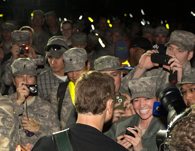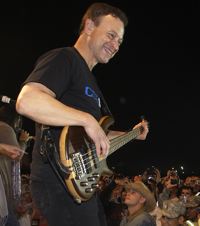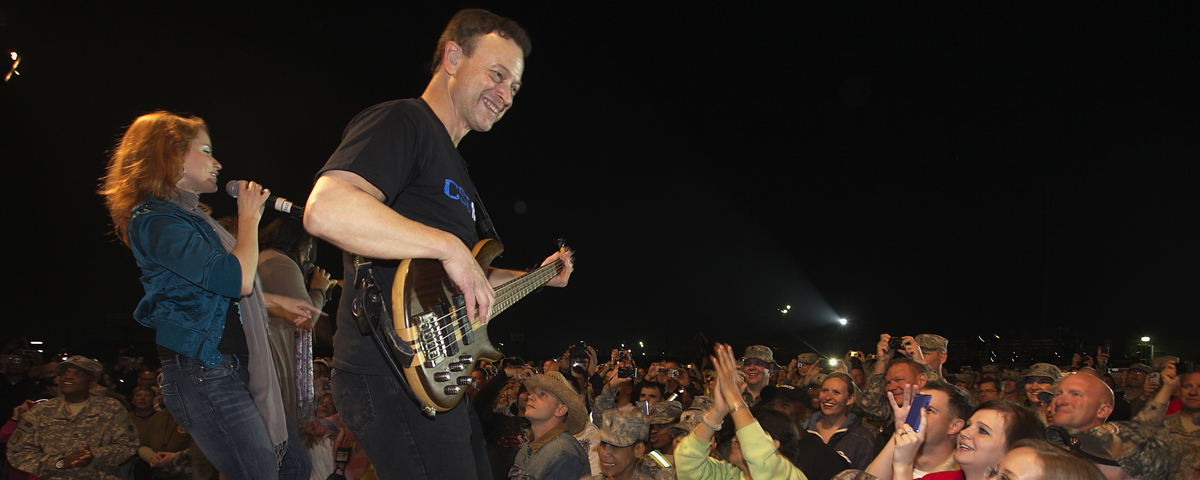While his role in Forrest Gump endeared Gary Sinise to Vietnam veterans, his compassion for them was stirred long before, on a stage in Chicago
Gary Sinise remembers registering with the Selective Service in 1973 and how his parents were worried he might get drafted. But by then, the Vietnam War was winding down and an 18-year-old had nothing to worry about. More focused on his rock band and acting, he didn’t really know much about the war at the time. “I was just a kid,” he said, “not paying too much attention to what was going on. I did know that things were bad and that there were protests everywhere.”
When Sinise took up acting in high school, he never looked back. After graduating, he and some friends boldly started their own theater company in Chicago in 1974. With Steppenwolf Theater Company, Sinise honed his acting talent and built a reputation as a director, found his wife Moira—one of the company’s original actors—and gained an awareness of the Vietnam War and those who fought it. Before long, his passion for the stage and belief in its power to connect and inform meshed with a newfound passion: to learn, and tell, the stories of Vietnam’s vets to a public that too often didn’t want to know.
While the actor’s Academy Award–nominated performance as Lieutenant Dan Taylor in the 1994 hit movie Forrest Gump is widely recognized as forging the actor’s link with Vietnam veterans, his understanding and advocacy for them began long before then.
“My wife had two brothers who did tours in Vietnam; one of them, Boyd McCanna “Mac” Harris, served two,” Sinise said. “I was very curious about Vietnam so I spent a lot of time talking with them about their experiences. Then in 1980, I read about a play that some Vietnam veterans were doing in Los Angeles. It was still a time when many vets hid the fact that they had been in Vietnam.”
Spurred by his brothers-in-laws’ stories and a sense of shame he felt for the treatment the country had given them and other vets, Sinise went to L.A. to see Tracers, created by John Di Fusco. The play had an all-Vietnam-vet cast, and of those, only two were professional actors; the rest were recruited via a newspaper advertisement.
“I was completely devastated by their performance; it was so powerful, I knew right away that I wanted to do it in Chicago,” Sinise said of Tracers. “I wanted people to see it so they could have a better understanding of what Vietnam vets had gone through in combat and when they came home.” But in 1980, Gary Sinise was just a kid from Chicago, and the veterans who put the play together weren’t too impressed. “I begged them to let me do it,” he said, “but they were committed to the idea that it should only be performed by veterans.”
Sinise was persistent: “Every few months I’d call and make my pitch. Then, it closed in L.A. and nothing was happening with it.” Eventually, Sinise prevailed in the fall of 1983 and secured the rights to stage the play in Chicago. At about the same time, Sinise’s brother-in-law Lt. Col. Mac Harris was stricken with cancer and died in October. “Mac’s passing became another motivator for me to tell the story of Vietnam vets and do it as accurately and honestly as I could,” Sinise said.
 Two members in Steppenwolf were Vietnam vets, Sinise recalled. “The rest of the guys were just actors and none as passionate as I was about telling Vietnam veterans’ stories.” To transfer the Tracers intensity to his nonvet performers would require some special preparation. “We would usually rehearse for three weeks before a production. But for Tracers, I asked my actors to give me an extra five weeks of just workshop rehearsal—for free!” Sinise had his cast study the Vietnam War, and he took the actors to the Great Lakes Naval Station VA hospital a number of times, where they listened to Vietnam vets, some suffering from PTSD, tell their stories. “I wanted to do things with the cast that would get them in the mood and focused on why we were telling the story before we actually started rehearsing,” said Sinise.
Two members in Steppenwolf were Vietnam vets, Sinise recalled. “The rest of the guys were just actors and none as passionate as I was about telling Vietnam veterans’ stories.” To transfer the Tracers intensity to his nonvet performers would require some special preparation. “We would usually rehearse for three weeks before a production. But for Tracers, I asked my actors to give me an extra five weeks of just workshop rehearsal—for free!” Sinise had his cast study the Vietnam War, and he took the actors to the Great Lakes Naval Station VA hospital a number of times, where they listened to Vietnam vets, some suffering from PTSD, tell their stories. “I wanted to do things with the cast that would get them in the mood and focused on why we were telling the story before we actually started rehearsing,” said Sinise.
But the real stroke of genius came when Sinise secured the use of an isolated Michigan summer camp, where he exposed his cast to intense boot-camp-like activities—in the dead of winter between Christmas and New Year’s. One of his Vietnam-vet actors, Dennis Farina, took the role of drill sergeant, whereupon “he beat the crap out of the guys,” Sinise recalled. On their last night there, “We had a big end-of-boot-camp blowout, a crazy night,” said Sinise. “The next day, we read the play for the very first time, then headed back to Chicago to start rehearsals. You know, by the time the play opened, the cast was as committed and dedicated to telling the Vietnam vets’ stories as I was.”
For the dress rehearsal of Tracers, Sinise invited only veterans, and subsequently, every Tuesday night of the performance was “Veterans Night.” That was the start of two traditions that have lasted for 25 years at the Steppenwolf. “Every Tuesday night during Tracers we would have 100 or more vets. Many just kept coming back every week,” he said. “For a lot of them, their story was being told in a way they hadn’t ever been able to talk about. It was cathartic and therapeutic for them.”
Through Tracers, Sinise became involved in a number of Vietnam veteran groups in the Chicago area and helped raise funds to build a Vietnam veterans memorial in Lansing, Ill. The appreciative group honored Sinise’s efforts by adding his brother-in-law’s name, Mac Harris, on the memorial.
By this time, Sinise had garnered wide acclaim for his directing and acting with John Malkovich in True West, which he had taken from Chicago to New York in 1982. In 1983 he took another production to New York, Balm In Gilead. With the success of Tracers, Sinise desperately wanted to take the play to New York. But his deal was exclusive to Chicago and Tracers’ creators ended up making their own deal, opening the play at New York’s Public Theater in January 1985.
Though he was disappointed, Sinise is indebted to the play: “It was a highlight in my career and really galvanized my support for Vietnam vets—and shame as an American for what had happened to them.” But the intersection of Sinise’s acting career and Vietnam was hardly over.
While in New York with his production of Balm In Gilead, Sinise heard that Oliver Stone was holding auditions for a movie called Platoon. “I auditioned to play one of the guys in the platoon,” he said. “I was dying to be in that because I wanted to continue telling stories about Vietnam vets. It looked like I might have a shot at getting the part, but then the project was put on hold for about a year.” By the time Platoon was ready to cast, Sinise was involved in another project.
Nine years later, author Winston Groom’s novel Forrest Gump was about to be made into a feature film, and Gary Sinise was about to play a role that would become his signature: “I very much wanted to do it and felt very prepared and ready to play that character because of all the Vietnam work that I’d done in the theater and because of so many Vietnam vets I’d gotten to know.” And missing Platoon may have been the best thing to happen to Sinise: “You know, if I’d gotten the role in Platoon, I may not have even been considered for Forrest Gump. Things have a way of working out.”
Sinise credits his preparations for Tracers in 1983 for his command of the Lieutenant Dan role in Forrest Gump: “I played a veteran who’d been severely injured and who was dealing with all kinds of anger, and I could call on those conversations I’d had with some very angry Vietnam vets at Great Lakes, who talked about some really harrowing things they did, how they were treated when they came home, and horrible things they were struggling with.
“All Lieutenant Dan wanted to do was to rise in the ranks and have a military career,” explained Sinise. “His destiny was to either become a great military leader or die on the battlefield; he never thought he would be wounded, lose his legs. So he goes through his anger, despair, isolation, all the stuff that so many veterans then and now understand. But in the end, he finds peace, and in the last image you have of him, he is clean cut, standing up on legs, he’s rich and successful.” Sinise said Lieutenant Dan served as an example of how many vets could, and did, overcome—a story that had not really been told before.
 Sinise soon heard from the Disabled American Veterans (DAV), a group he said he’d known little about: “They wanted to give me something at their convention, so I said sure. When I walked out on that stage and saw all these disabled vets clapping—those who could were standing, some on one leg, guys in wheelchairs with only one arm—I was so moved. They just wanted to thank me for playing a disabled vet in what they considered a positive way.” Sinise has been involved with DAV ever since.
Sinise soon heard from the Disabled American Veterans (DAV), a group he said he’d known little about: “They wanted to give me something at their convention, so I said sure. When I walked out on that stage and saw all these disabled vets clapping—those who could were standing, some on one leg, guys in wheelchairs with only one arm—I was so moved. They just wanted to thank me for playing a disabled vet in what they considered a positive way.” Sinise has been involved with DAV ever since.
Sinise never imagined the longevity Lieutenant Dan would have, and how intensely Vietnam veterans would identify with the character. While he continued to support veteran causes as his career soared (Apollo 13, Truman, CSI: Miami/New York…), 9/11 and the war on terror drove him to do even more. He quickly signed up to visit the troops and the wounded for the USO.
“A pretty good” bass guitarist, as he puts it, Sinise had for years jammed regularly with a group of friends, including Vietnam vet, composer and professor Kimo Williams. Working with the USO, shaking hands and signing autographs, Sinise saw an opportunity to turn his hobby into an effective way to entertain the troops. In 2004 The Lt. Dan Band was born, becoming a regular on military bases around the world and performing on nearly 50 USO tours since.
Beyond the band, as the wars continued, Sinise became increasingly involved in endeavors to support the troops, veterans and their families, as well as charitable organizations such as Operation Iraqi Children, 9/11 memorials at the Pentagon, the Brooklyn Wall of Remembrance, American Veterans Disabled for Life Memorial and others. Since 2006 Sinise has been one of the hosts of the Memorial Day Concert in Washington. In 2008 Sinise became only the second actor among the 110 people who have been awarded the Presidential Citizens Medal.
As if that weren’t enough, last year Sinise launched the Gary Sinise Foundation, with the mission to honor the nation’s defenders, veterans, first responders, their families and those in need. An example of the foundation’s work is its partnership with Building Homes for Heroes, which builds specially designed homes for severely wounded service members and their families.
Sinise sees a big role for Vietnam veterans to play today, in supporting the troops and helping the newest generations of veterans readjust and reintegrate into society: “I’ve met a lot of Vietnam vets who are giving back now because they want to make sure our active-duty folks in Iraq and Afghanistan don’t go through the same crap they went through. Many Vietnam vets have found a way to turn things around by taking care of our young folks now.”
Much like when he was a young actor in Chicago, awakened to the meaning of sacrifice by Vietnam veterans, Gary Sinise is infused with an intense desire to ensure that those who serve today are properly honored for what they do and those who fall are properly cared for forever. “I have an ability to do something to help them,” he said. “I’ve seen it make a difference so many times when somebody like me gets involved and shows support. I’ve been blessed with a good career and a level of fame that can be used for something positive. I like doing what I do; it’s a way to give back.”
For more information on the Gary Sinise Foundation, go to www.garysinisefoundation.org





